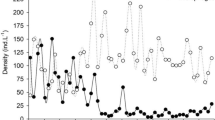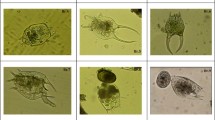Abstract
The Okavango Delta has an annual flood cycle that spreads slowly from the northwestern`panhandle' into a widening delta to the southeast. Rotifers were sampled from areas where the flood was active, and from other areas not yet reached by the flood. In still waters, the samples were dominated by euplanktonic rotifers, particularly of the genera Brachionus, Keratella and Hexarthra, with about 20 species per 1000 individuals at a station. Where the water was moving the samples were dominated by periphytic rotifers, with over 100 species per 1000 individuals at a single station. The periphytic species were dominated by the genus Lecane,with over 45 species, followed by Lepadellawith 24 species, and Trichocercawith 23 species. Comparison of the Okavango with six other tropical localities reveals fairly consistent ratios of the numbers of species in the periphytic genera Lecane, Lepadellaand Trichocerca,indicating that there may be assembly rules for communities of tropical periphytic rotifers.
Similar content being viewed by others
References
Beauchamp, P. de, 1952a. Un facteur de la variabilite chez les rotiferes du genre Brachionus. C. r. hebd. Seanc. Acad. Sci. Paris 234: 573–575.
Beauchamp, P. de, 1952b. Variation chez les rotiferes du genre Brachionus. C. r. hebd. Seanc. Acad. Sci. Paris 235: 1355–1356.
Chao, A., 1987. Estimating the population size for capture-recapture data with unequal catchability. Biometrics 42: 783–791.
De Ridder, M. & H. Segers, 1997. Monogonont Rotifera recorded in the World literature (except Africa) from 1960 to 1992. Doc. trav. Inst. roy. Sci. nat. Belge 88: 1–481.
Duggan, I. C., J. D. Green, K. Thompson & R. J. Shiel, 1998. Rotifers in relation to littoral ecotone structure in Lake Rotomanuka, North Island, New Zealand Hydrobiologia 387/388: 179–197.
Dumont, H. J. & H. Segers, 1996. Estimating lacustrine zooplankton species richness and complementarity. Hydrobiologia 341: 125–132.
Gilbert, J. J., 1967. Asplanchna and postero-lateral spine production in Brachionus calyciflorus. Arch. Hydrobiol. 64: 1–62.
Gilbert, J. J., 2001. Spine development in Brachionus quadridentatus from an Australian billabong: genetic variation and induction by Asplanchna. Hydrobiologia 446/447: 19–28.
Godward, M., 1934. An investigation of the causal distribution of algal epiphytes. Beih. Bot. Zentralbl. 52: 506–539.
Gosse, P. H., 1886. In Hudson, C. T. & P. H. Gosse (eds), The Rotifera or Wheel-Animalicules. Longmans, Green & Co., London.
Green, J., 1960. Zooplankton of the River Sokoto. The Rotifera. Proc. zool. Soc. Lond. 135: 491–523.
Green, J., 1967. Associations of Rotifera in the zooplankton of the lake sources of the White Nile. J. Zool., Lond. 151: 343–378.
Green, J., 2001. Variability and instability of planktonic rotifer associations in Lesotho, Southern Africa. Hydrobiologia 446/447: 187–194.
Green, J. & B. L. Oey, 1974. Asplanchna and the spines of Brachionus calyciflorus in two Javanese sewage ponds. Freshwat. Biol. 4: 223–226.
Hustedt, F., 1922. Die Bacillariaceen-Vegetation des Lunzer Seengebietes. Int. Rev. ges. Hydrobiol. Hydrog. 10: 40–74, 233–270.
Hutchinson, G. E., 1975. A Treatise on Limnology. Volume 3–Limnological Botany. Wiley & Sons, New York: 660 pp.
Koste, W., 1974. Zur Kenntnis der Rotatorienfauna der "schwimmenden Weise’ einer Uferlagune in der Varzea Amazoniens, Brasilien. Amazoniana 5: 25–59.
Koste, W., 1988. Rotatorien aus Gewassern am Mittleren Sungai Mahakam, einem Uberschwemmungsgebeit in E-Kalimantan, Indonesian Borneo. Osnabrucker naturwiss. Mitt. 14: 91–136.
Koste, W. & B. Robertson, 1983. Taxonomic studies of the Rotifera (Phylum Aschelminthes) from a central Amazonian varzea lake, Lago Camaleao (Ilha de Marchantaria, Rio Solimoes, Amazonas, Brazil). Amazoniana 8: 225–254.
Magurran, A. E., 1988. Ecological Diversity and its Measurement. Croom Helm, London: 179 pp.
May, L., 1986. Rotifer sampling–a complete list from one visit? Hydrobiologia 134: 117–120.
Pejler. B. & B. Berzins, 1989. On choice of substrate and habitat in brachionid rotifers. Hydrobiologia 186/187: 137–144.
Pennak, P.W., 1966. Structure of zooplankton populations in the littoral macrophyte zone of some Colorado lakes. Trans. am. micr. Soc. 83: 329–349.
Pontin, R. M. & R. J. Shiel, 1995. Periphytic rotifer communities of an Australian seasonal floodplain pool. Hydrobiologia 313/314: 63–67.
Pourriot, R., 1970. Quelques Trichocerca (Rotiferes) et leurs régimes alimentaires. Ann. Hydrobiol. 1: 155–171.
Rosenzweig, M., 1999. Species diversity. In McGlade, J. (ed.), Advanced Ecological Theory. Blackwell, Oxford.
Sanoamuang, L., 1998. Rotifera of some freshwater habitats in the floodplain of the River Nan, northern Thailand. Hydrobiologia 387/388: 27–33.
Scudder, T. et al., 1992. The IUCN Review of the Southern Okavango Integrated Water Development Project. Final Report. IUCN.
Segers, H., 1995. World records of Lecanidae (Rotifera, Monogononta). Doc. trav. Inst. roy. Sci. nat. Belge 81: 1–114.
Segers, H. & H. J. Dumont, 1995. 102+ rotifer species (Rotifera: Monogononta) in Broa reservoir (SP., Brazil) on 26 August 1994, with the description of three new species. Hydrobiologia 316: 183–197.
Segers, H., C. S. Nwadiaro & H. J. Dumont, 1993. Rotifers of some lakes in the floodplain of the River Niger (Imo State, Nigeria). II Faunal composition and diversity. Hydrobiologia 250: 63–71.
Shiel, R.J., J.D. Green& D.L. Nielsen, 1998. Floodplain biodiversity: whyarethere somanyspecies? Hydrobiologia 387/388: 39–46.
Taylor, L. R., 1978. Bates, Williams, Hutchinson–a variety of diversities. In Mound, L. A. & N. Warloff (eds), Diversity of Insect Fauna; 9th Symposium of the Royal Entomological Society. Blackwell, Oxford: 1–18.
Walsh, E. J., 1995. Habitat-specific predation susceptibilities of a littoral rotifer to two invertebrate predators. Hydrobiologia 313/314: 205–211.
Williams, C. B., 1964. Patterns in the Balance of Nature and Related Problems in Quantitative Ecology. Academic Press, London.
Wilson, B. H. & T. Dincer, 1976. An introduction to the hydrology and hydrography of the Okavango Delta. In: Proceedings of the Symposium on the Okavango Delta and its future utilisation. Botswana Society, Gabarone.
Author information
Authors and Affiliations
Rights and permissions
About this article
Cite this article
Green, J. Associations of planktonic and periphytic rotifers in a tropical swamp, the Okavango Delta, Southern Africa. Hydrobiologia 490, 197–209 (2003). https://doi.org/10.1023/A:1023475217987
Issue Date:
DOI: https://doi.org/10.1023/A:1023475217987




